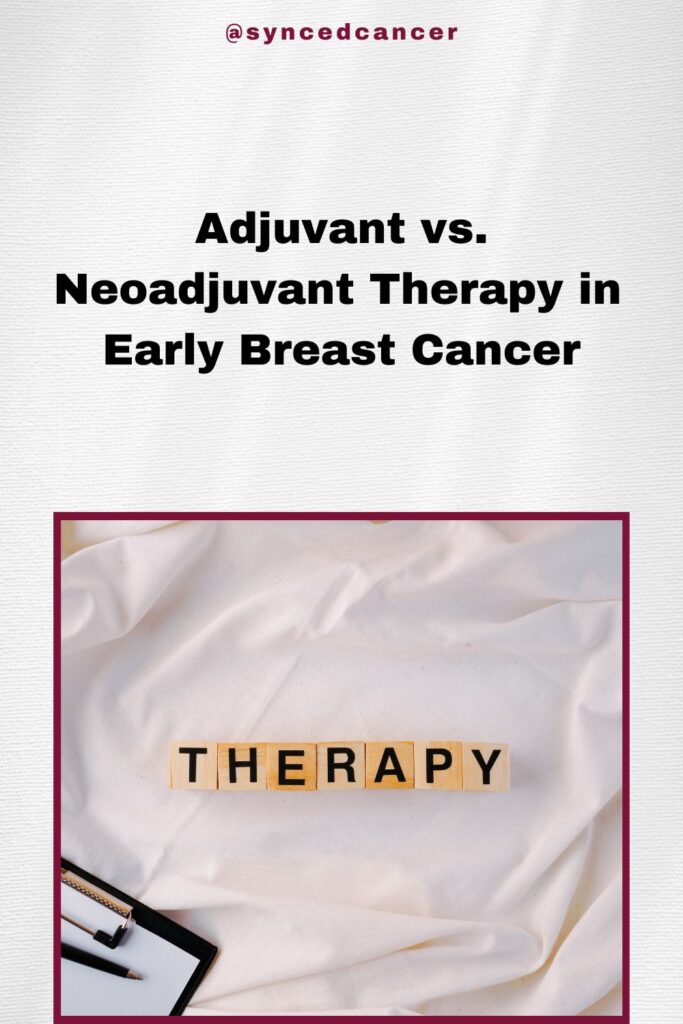When you or a loved one is diagnosed with breast cancer, the amount of information can feel overwhelming. Along with dealing with emotions, you’re beginning to hear medical terms you may not be familiar with—terms like “adjuvant” and “neoadjuvant” therapy. These are two approaches doctors use to treat early-stage breast cancer, but what do they mean, and how are they different? Both are aimed at improving outcomes, but their timing and purpose differ, making it essential to understand the differences. Let’s break it down simply and constructively.
Understanding Adjuvant and Neoadjuvant Therapy
First, it’s important to start with a basic understanding of how breast cancer is generally treated, especially in its early stages. For most patients with early-stage breast cancer, surgery is often the first line of treatment. The goal is to remove the tumor, which can be done either through a lumpectomy (removal of the tumor and some surrounding tissue) or a mastectomy (removal of one or both breasts, sometimes including nearby lymph nodes).
However, surgery alone is often not enough to ensure that all the cancer cells are gone. Breast cancer, even when detected early, has the potential to spread tiny, undetectable cancer cells beyond the primary tumor. That’s where systemic therapies like chemotherapy, hormone therapy, and radiation come into play—they help to kill off any remaining cancer cells and reduce the risk of recurrence. This is where adjuvant and neoadjuvant therapies come in.
1. Adjuvant Therapy: Think of this as a “follow-up treatment.” It happens after surgery and aims to kill any leftover cancer cells that are too small to see but might still be in the body. These lingering cancer cells could potentially grow into new tumors later. Adjuvant therapy acts as a safety net to reduce the chances of the cancer coming back (recurrence). This follow-up treatment can involve:
- Chemotherapy: Using drugs to kill cancer cells throughout the body.
- Radiation Therapy: Targeted energy (usually X-rays) that kills cancer cells left in the breast or surrounding tissue.
- Hormone Therapy: Medications that block hormones like estrogen, which fuel the growth of some types of breast cancer.
- Targeted Therapy: Drugs that target specific genes or proteins involved in cancer growth.
2. Neoadjuvant Therapy: This is a “pre-treatment,” given before surgery to shrink a tumor and make it easier to remove. Sometimes, tumors are too large or located in a way that makes surgery difficult. Neoadjuvant therapy helps make surgery more effective or less invasive. It can also give doctors an early look at how the cancer responds to treatment, which can inform the next steps.
Similar to adjuvant therapy, neoadjuvant therapy can involve chemotherapy, hormone therapy, or targeted treatments, depending on the specific type of breast cancer.

Why Choose One Over the Other?
The decision between adjuvant and neoadjuvant therapy depends on several factors, including the size of the tumor, whether the cancer has spread, and the type of breast cancer. Here’s a human-centered breakdown of why doctors choose one over the other:
- Adjuvant Therapy is usually recommended if the cancer is caught early and surgery alone may be enough to remove the tumor. Doctors use it as a precaution to make sure any remaining microscopic cancer cells are wiped out.
- Neoadjuvant Therapy is often recommended if the tumor is large or if it’s located in a tricky area where surgery might not be possible right away. By shrinking the tumor first, neoadjuvant therapy can make the surgery less extensive, preserving more of the breast tissue or making the tumor easier to remove. This approach may also reduce the need for more aggressive surgery to remove nearby lymph nodes.
The Human Side: How It Feels to Undergo These Treatments
Understanding what these therapies do is one thing, but it’s also important to acknowledge how it feels to go through them.
- Adjuvant Therapy: After surgery, many patients feel relieved to have the tumor removed, but adjuvant therapy can extend the treatment period when they might be hoping to move on. There’s often a sense of, “Haven’t I already done enough?” The truth is, adjuvant therapy is an important insurance policy against recurrence, but the fatigue from chemotherapy or the inconvenience of radiation can be draining. Staying focused on the long-term goal of reducing cancer’s return can help patients push through.
- Neoadjuvant Therapy: Before surgery, neoadjuvant therapy can create a mix of hope and anxiety. Patients might feel reassured seeing the tumor shrink on scans, knowing the treatment is working. However, the wait for surgery can feel long, especially when patients are eager to have the tumor removed. In some cases, the side effects of chemotherapy—like hair loss or fatigue—begin early in the treatment process, adding another layer of challenge.
Your Role in Decision-Making
Ultimately, the decision between adjuvant and neoadjuvant therapy is one that you make with your doctor. It’s important to ask questions and fully understand your options. Every woman’s experience with breast cancer is different. Factors like the size and location of the tumor, the type of breast cancer, your overall health, and your personal preferences all play a role in the decision.
Here are some good questions to ask:
- What are the goals of this therapy for me?
- How will this affect my daily life?
- What are the possible side effects for this treatment?
- Will I need chemotherapy or radiation, and if so, when?
- Can neoadjuvant therapy help me avoid more aggressive surgery?
- How does this treatment affect my overall chances of beating cancer?
Conclusion
While both adjuvant and neoadjuvant therapies are vital tools in fighting breast cancer, each has its own role depending on your situation. The best choice for you will depend on the size and type of your tumor, your overall health, and your personal preferences.
The most important thing to remember is that you don’t have to navigate these decisions alone. Your healthcare team is there to guide you every step of the way, providing treatment to give you the best possible outcome. Breast cancer can cone with lots of emotions, but by understanding your options like adjuvant and neoadjuvant therapies, you’re taking a significant step in regaining control of your health journey.
Breast cancer is personal, and so is the treatment—choose what works best for you, with your team’s guidance.
REFERENCES
Syncedcancer – https://www.syncedcancer.com/questions-to-ask-as-a-cancer-patient/https:/.
Accessed 20th October,2024










What do you think?
It is nice to know your opinion. Leave a comment.